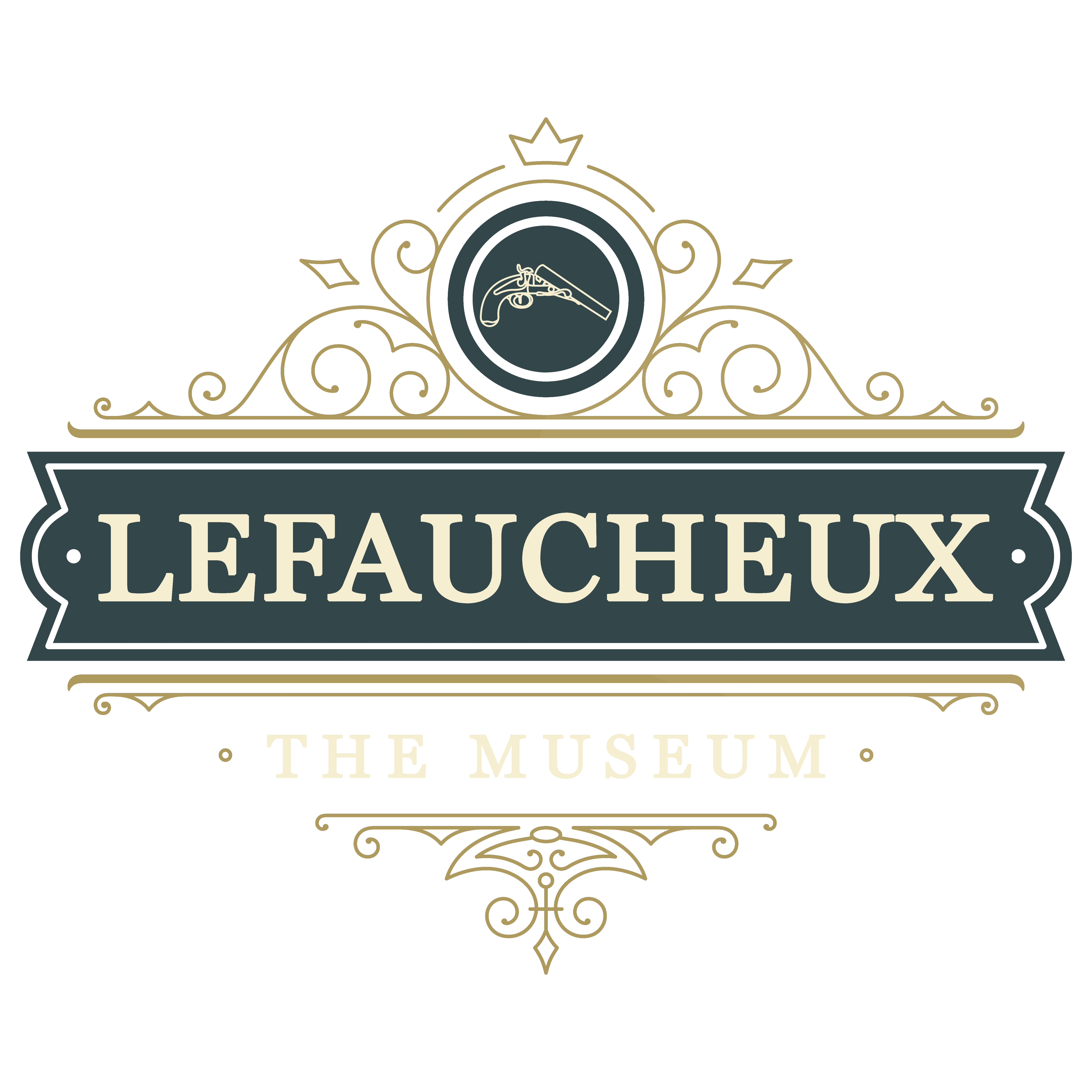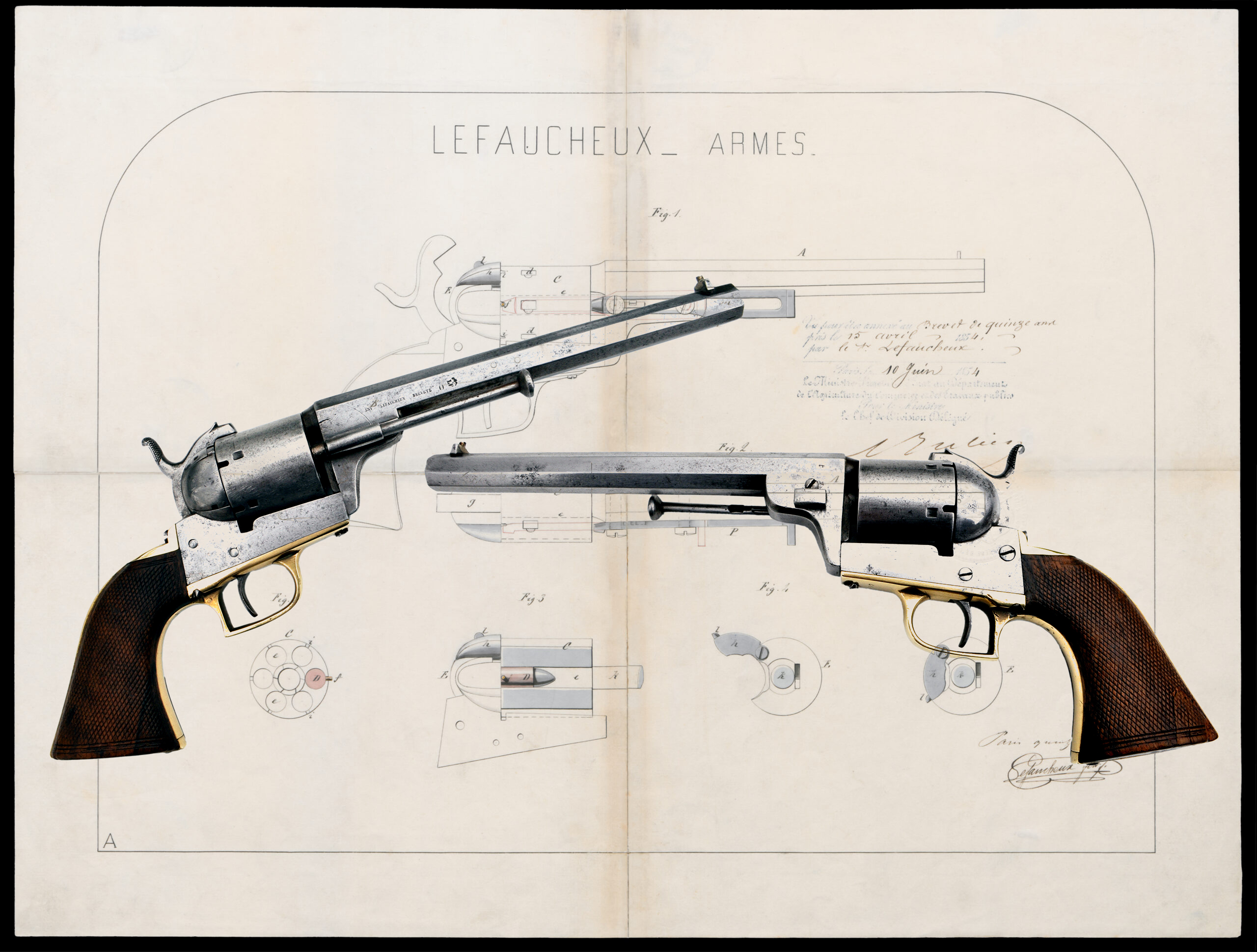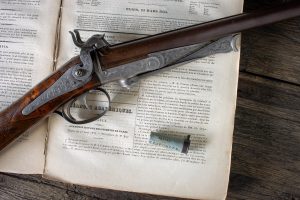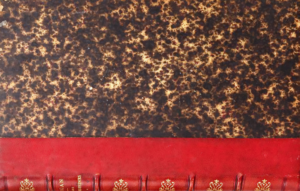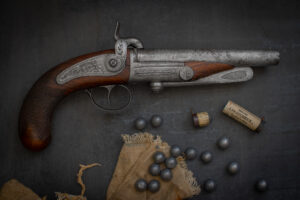Every arms collector is in search of their ultimate piece. But for that you need a lot of luck, flair, and be in the right place at the right time. This was the case with the LF 0, the central object of our article.
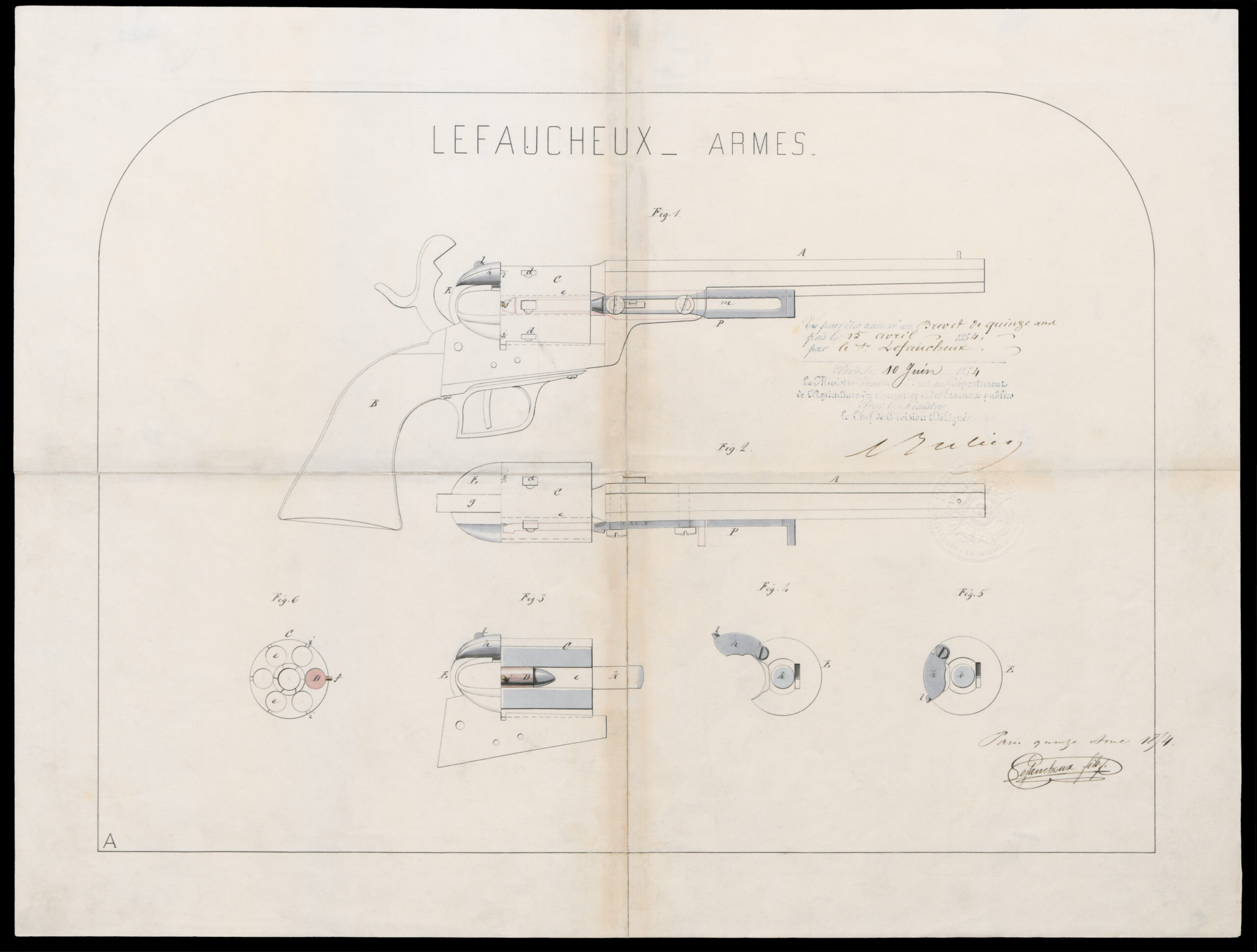
Source: French patent & trademark office
Shown above is a copy of patent 19,380 of April 15, 1854, filed in Paris that appears to be a Colt Navy ’51 modified for the pinfire system. In November 2013, I had managed to acquire the LF28, an example that follows patent 955 registered in London, only 12 days after the Paris patent. A full-size drawing of this patent is also in the Eugène Lefaucheux family archives which I manage. Shortly after, we discovered the LF 25, property of Samuel Colt at the Connecticut Historical Museum in Hartford USA. According to American sources, Colt would have bought this revolver directly from Eugène Lefaucheux at his stand at the 1855 Universal Exhibition in Paris. While researching for our book, Eugène Gabriel Lefaucheux Nineteenth-century arms manufacturer in Paris and Liège, we came across a report from the French Navy that mentions the LF7 and finally, in a newspaper article of the time that leads us to the probable LF 1 which would have been field tested during the Crimean War. This is how knowledge about the earliest revolvers manufactured by Lefaucheux is expanding. But the LF28 remained the oldest in a private collection. With the LF28 it seemed to us that the lowest number of the M1854 had been found… until December 2022!
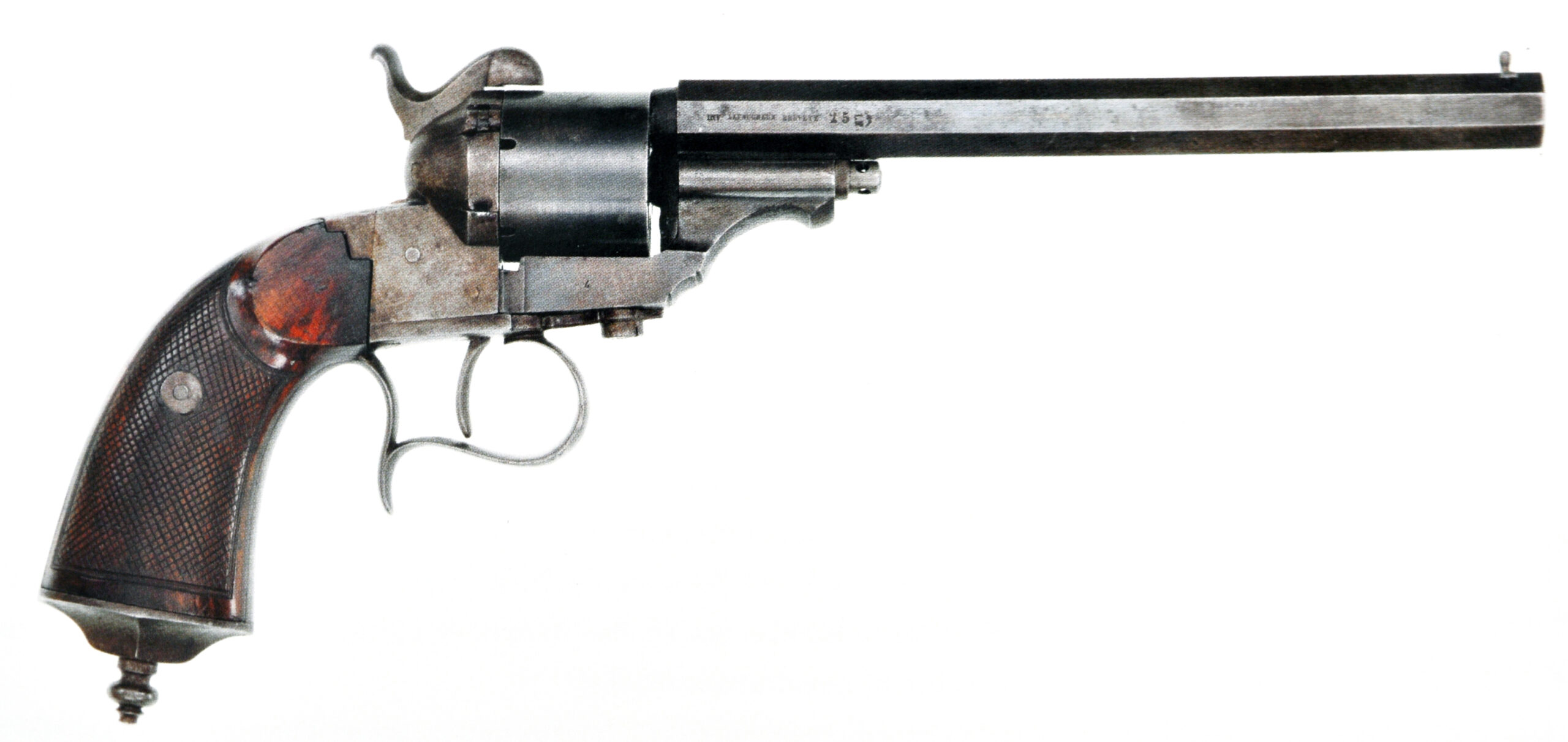
Shortly before, a new Facebook page dealing only with pinfire weapons was created and a person presented there (asking for information) a revolver looking like a Colt 1851 with the number 2157, but pinfire with a Lefaucheux marking, “Inv. Lefaucheux breveté LF 0”. My heart “did a double flip” but I remained skeptical, telling myself “No this is not possible” …. Well, I had just found the beginning of the M1854 saga and after multiple discussions and twists and turns, I was able to acquire this piece.
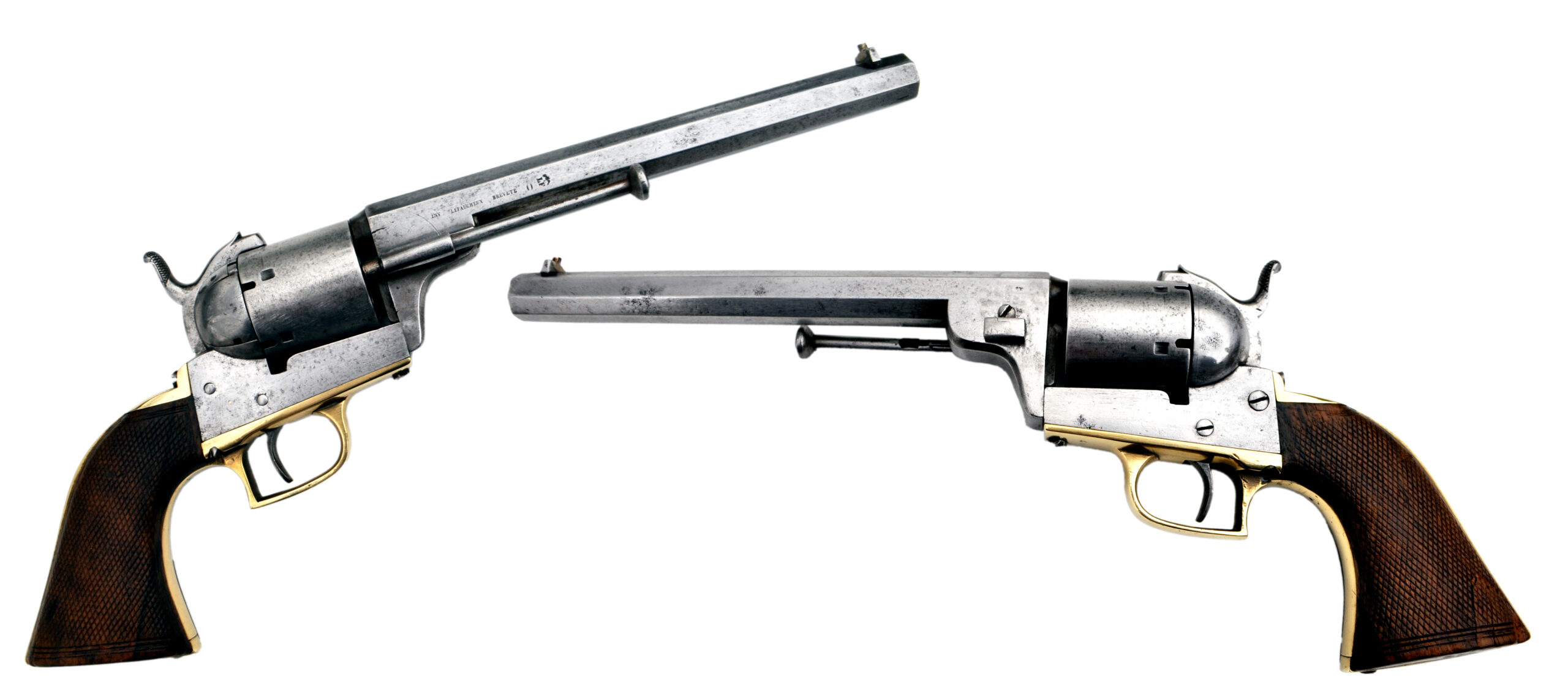
The only question that remains unanswered is how a prototype of this kind could have crossed time incognito and arrived at the penultimate owner without being lost, destroyed or other …. It is suspected that the revolver was already in the family before that. We compared the genealogical data obtained with the 220 names on the list of personnel at Eugène Lefaucheux’s factory in Paris. Unfortunately, no match was found.
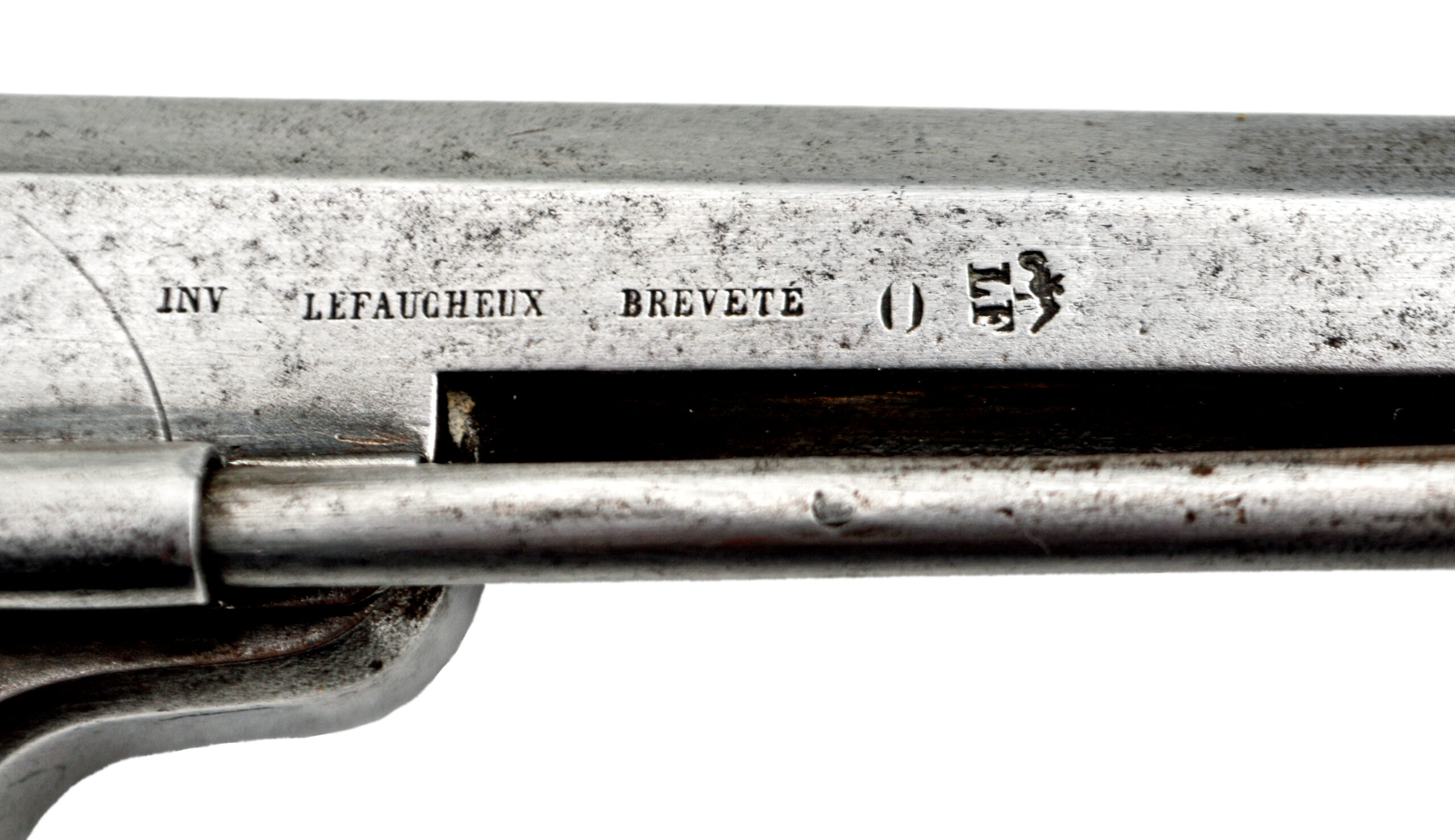
Below we describe the process we followed to draw conclusions about the origin of this Colt, which could also be Eugène Lefaucheux’s first pinfire revolver.
In any case, this revolver was not somewhere in the United States, but a few kilometers from my home in Rouen, France. I went to see the weapon, then we immersed ourselves in the literature. We first took important information from the American Society of Arms Collectors article “The London-made ’51 Colt Navy with a comparison to its Hartford-made counterpart“, written by Nathan L. Swayze.
The revolver appears to be entirely made with Colt parts, both frame and barrel, as well as cylinder. At first glance, except for details, the gun looks a lot like a second model Colt Navy 1851 produced in Hartford between fall 1850 and mid-1851 and appears to be between numbers 900 and 4200. The number 2157 on the Lefaucheux prototype fits perfectly. The brass trigger guard is square and small, a solid finger barely fits in it. This is what is called the “squareback” trigger guard characteristic of the first and second Navy models. After looking at the LF 0, a prominent connoisseur and collector of Colt firearms judged that the width of the trigger guard indicated more of a Baby Dragoon. The angled grip is typical of Belgian manufacture. So he leans towards a Colt Breveté made in Belgium. Comparison with some of his Hartford Colts clearly showed it. We also immersed ourselves in the production of the Colt factory in London. However, we found little evidence there…
Due to the various details such as the width of the trigger guard and the inclination of the grip as well as the smooth barrel, we expanded our research to Belgian Colt Breveté revolvers, as they were both legally manufactured under license and illegally, notably in Liège. An American expert pointed to a Colt Breveté Baby Dragoon, with serial number 2461, which has the same features as the revolver bearing number 2157, the Lefaucheux prototype. The Colt Breveté is depicted in the standard work “Colt Breveté Revolvers” by Marcot and Paxton and is stamped with the proof house and inspection marks of Liège. It is therefore undeniably a Belgian product.
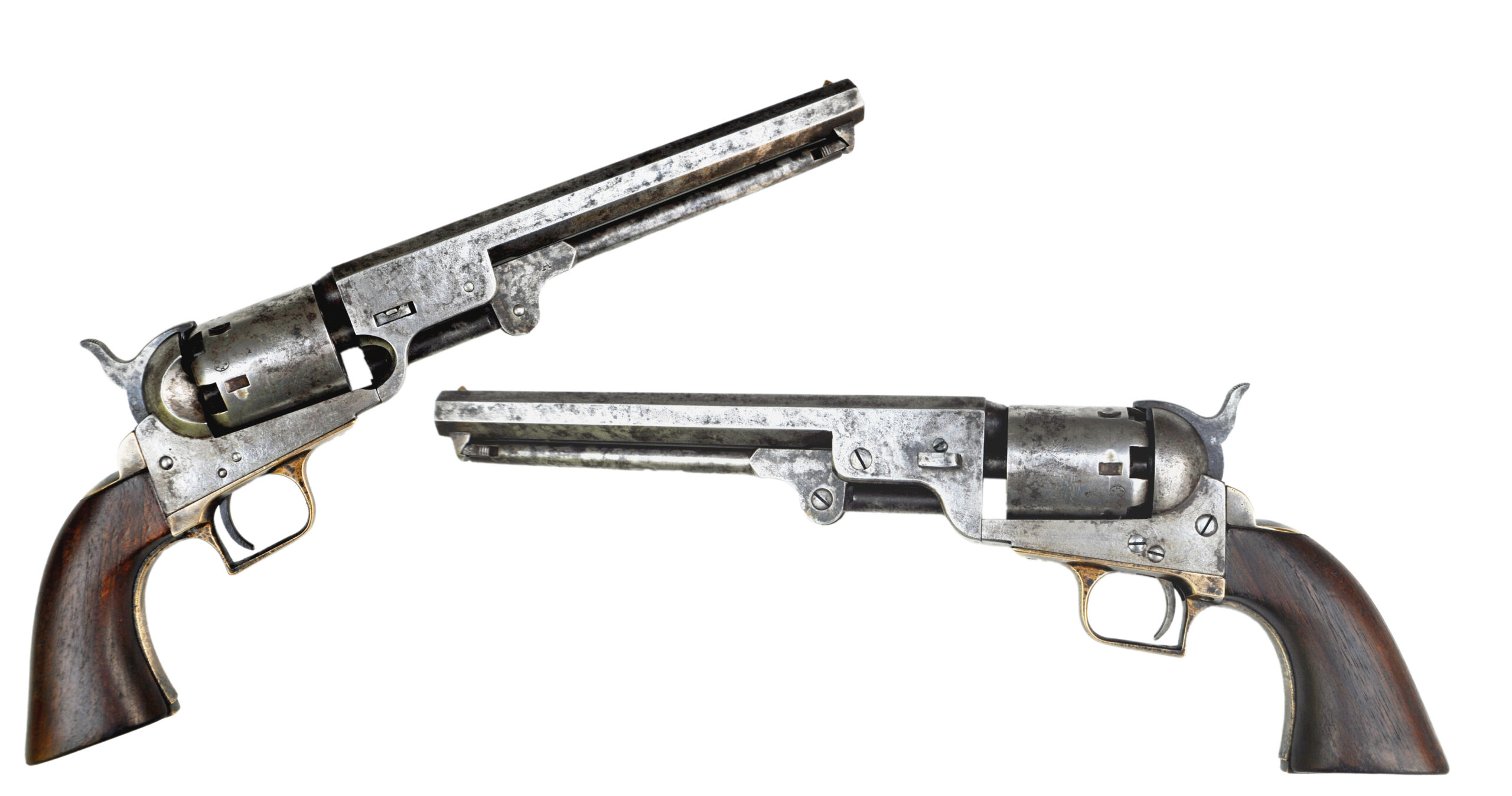
After comparing many examples on auction sites and others, we asked ourselves the following questions:
Why or why not a Colt from Hartford? The weapon’s number 2157 is part of the series of Colt Navy ’51 revolvers that came from the United States to London. The revolver could have been shipped to Liverpool, England in early 1851, sent to London and then from May 1851 presented at the first World Exhibition. The brass parts refer to the American origin. Straight screws are mainly found on Hartford Colt revolvers. Nevertheless, the American origin of this revolver does not seem to hold up, given the divergent details seen previously.
Why or why not a revolver from the Colt factory in London? The number 2157 also fits into the range of British Colts. Only, the date of manufacture would then be late 1853, early 1854. The shape of the grip, slightly flared, is typical of the London model. Production in London is put in motion when the design and testing of Lefaucheux is already completed and the patent is ready to be filed. This therefore excludes a British origin of the weapon.
Why would the Colt be made in Liège? From 1851, Colt sold licenses to Liège industrialists. They paid 10 francs for the revolver and could then sell it with the Colt Breveté marking. Colt’s arms representative in Liège, Devos Sera, will be replaced in 1853 by John Sainthill. Pirlot Frères, Auguste Francotte and Victor Collette, for example, had such a license among more than thirty other manufacturers. Original Colt parts from Hartford were often used, such as brass trigger guards and grip parts. Our hypothesis is that Eugène Lefaucheux would have sourced “Colt Breveté” revolvers from the companies where he worked as an apprentice during those years. It is unlikely that a single Colt was enough to make all the technical changes at once. A strong argument for the Liège origin of the prototype is that the patent drawing of April 15, 1854 also shows a Colt with an angled grip. All these elements completed by the specific information of the Colt experts consulted, point to Liège. Moreover, the distance Paris-Liège was easier and faster to travel than Paris-London or Paris-Hartford.



All this does not change the fact that Eugène Lefaucheux was inspired by the Hartford Colt Navy ’51 when he saw it at the London World Exhibition, in order to put into practice his idea of a revolver with a cylinder drilled all the way through.
This is indeed what I hear most often when the subject is raised: “Well yes, he took a Colt and then he only drilled through the cylinder …. And that’s it”. As Cyrano would say “It’s a little short young man” since a close examination of the revolver revealed 23 more or less notable modifications.
Here are the most important modifications:

The barrel, including the front frame: The lever under the octagonal barrel to press the ball into the chamber as well as the hinge and its mechanism have been removed. The opening at the front of the frame through which the lever passed is plugged but still clearly visible. The removal of the hinge mechanism made it possible to reduce the front frame. On the right rear, the curve of this front frame is filled with a rectangular metal piece that supports the attachment point of the ejector rod. The drawing of patent 19380 of April 15, 1854 shows a sliding latch instead of an ejector rod. The end of the latch has an “L” shape.
The question is whether the revolver drawn in the April 15, 1854 patent was manufactured, because 12 days later, on April 27, 1854 (in France on November 5, 1854) Lefaucheux filed the design of his original M1854 revolver in London. This latch is not found on the images accompanying the London patent, nor on any known copy, such as Samuel Colt’s LF25 or the LF28 in my collection. These models have an ejector rod, initially with an L-shaped end, but from LF42 with a “nail head” end. Lefaucheux replaced the front sight on the barrel with a raised one, because of the modification of the hammer shape, correcting the sight line. At the bottom of the barrel near the muzzle, we can clearly see that the attachment support for the lever has been replaced by a metal part. Between the barrel and the cylinder, a metal spacer is screwed with a round cutout for the central axis. The barrel is fixed with a key through the front frame. It is smooth and has a caliber of about 9 mm.

The cylinder: The Colt revolver cylinder was shortened by sawing off the rear piece. The length was thus reduced from 43 mm to 36.5 mm. With this, the percussion nipples disappeared. The rear received a new indexing ratchet with six notches and six grooves to lock the cylinder. The square cutouts on its periphery became superfluous. The six chambers are completely drilled and provided with cutouts for the passage of the cartridge pins. The central axis also had to be shortened to match the slot with the key that fixes the barrel. Eugène Lefaucheux replaced the slotted axis with a smooth axis with a narrow flat spring that serves as a cylinder rotation brake. This rotation brake has been the subject of much study and reflection since several locations are observed on the first 100 revolvers of the same model.



The frame: The cylinder lock having been modified, the screw of the Colt locking cam is no longer there. The Colt locking system worked from below. When the hammer was cocked, a cam engaged in one of the six cutouts on the perimeter of the cylinder. Eugène Lefaucheux placed on the right of the hammer, a pin that slides horizontally through the breech, simultaneously locking the cylinder at the rear in one of the grooves when the hammer is “cocked”. The screw hole of the original Colt locking system has been closed, but still remains clearly visible on the left side of the frame, just in front of the trigger axis. The removal of the Colt lock was necessary in order to create a passage in the frame for the cartridge pins during the rotation of the cylinder. The cavity on the right in the Colt’s breech, necessary to place the percussion caps on the nipples, has been re-filed for the introduction of the cartridges and equipped with an upwardly articulated door following the convex shape of the breech.


The hammer of the Colt revolver strikes on the back of the percussion caps. The breech has been modified on top for the passage of the hammer. The head of the hammer has been modified in order to be able to tap over, on the lugs of the pinfire cartridges. The frame had to be adapted to the shortened cylinder, but the connection to the front frame did not change. The two holes in which the pins of the front frame are inserted were kept. As a result, there is a slight misalignment between the frame and the barrel at this connection.
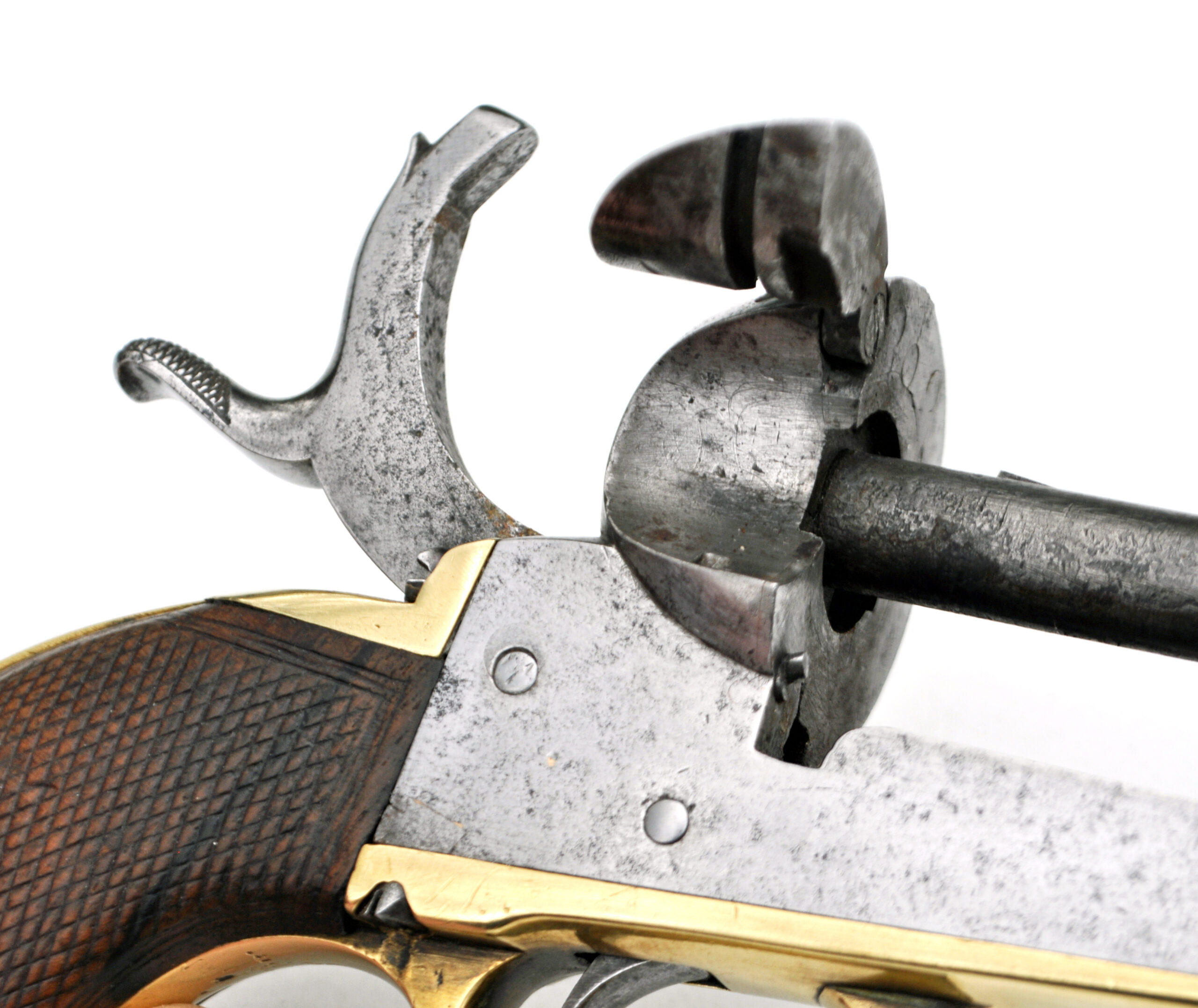

The cocking is two notches: first notch, the cylinder rotates freely allowing the loading and unloading of ammunition, the second notch puts the hammer to the armed position and locks the cylinder with the pin mentioned above.
Since we are dealing with a prototype, the weapon does not have many markings or hallmarks. Under the wood of the grip, on the lower arm of it, an “S” whose meaning I do not know. The Colt number 2157 on the brass part in front of the trigger guard. On the right side of the barrel: “Inv. Lefaucheux breveté LF 0” surmounted by the famous open pistol. I did not observe any other markings.
The results of our research so far do not contradict the fact that Eugène Lefaucheux designed his first pinfire revolver using a Colt, patented or not. The address on the barrel, including the number marking and typography, is indisputably that of Lefaucheux. All the construction modifications are found on the first known Lefaucheux M1854 revolvers. There does not seem to be any suspicion of counterfeiting. Who would make 23 modifications to a Colt and recreate the Lefaucheux markings at a time when Lefaucheux revolvers were little appreciated in the world of collectors? And where was the example?
Taking into account all these details, as well as the marking on the right side of the barrel, I think I have got my hands on the very first prototype and the beginning of the M1854 saga that will make the fortune of our gunsmith Eugène Lefaucheux.
Weight of the weapon: 1015 grams.
Total length of the weapon: 332 mm.
Barrel length: 185 mm, octagonal over its entire length, smooth interior.
Trigger guard and grip arms: brass.
Caliber: 9/10 mm pinfire
Cylinder: 6 shots, length 36.5 mm, diameter 39 mm.
Hammer: 2 notches.
Mechanism: Single action.
Grip: Checkered wood and in one piece.
Sources:
- Colonel Colt London. Joseph G. Rosa.
- Colt Breveté Revolvers. Roy Marcot & Ron Paxton.
- Colt revolvers in the Royal Armouries. Joseph G. Rosa.
- Eugène Gabriel Lefaucheux. 19th-century Arms Manufacturer in Paris and Liège. Guillaume van Mastrigt and Arie Slingerland.
- Eugène Lefaucheux, the French Samuel Colt. Tradition 227 and 228.
- Flayderman’s 8th edition.
- History of Colt firearms. Dean K. Boorman.
- History of London Colts. George Prescott. Classic Arms. Feb./Mar 2017.
- Information from Frank Ratelband. Collector of Colt revolvers.
- Information from Aaron Newcomer. American pinfire weapons specialist.
- The Colt 1851 versus the Lefaucheux 1854. Henri Vuillemin. Gazette des Armes 416.
- Transition from straight to round trigger guards on ’51 Colt Navies. Frank Ratelband. Wapenfeiten 2/2018.
- Pierre Joseph Fagard 1816-1858. Part 1. Richard Cootmans. Wapenfeiten 4/2013.
- Production of Eugène Lefaucheux Models. Guillaume van Mastrigt. Crépin-Leblond 2016.
- Samuel Colt Arms, Art and Invention. Herbert G. Houze.
- Samuel Colt and Eugène Lefaucheux. A. Slingerland. G. van Mastrigt. Cibles 561 December 2016.
- Samuel Colt and Eugène Lefaucheux. A. Slingerland. G. van Mastrigt. Cibles 562 January 2017.
- The London-made ’51 Colt Navy with a comparison to its Hartford-made counterpart. Nathan L. Swayze.
- The Revolver 1818-1865. A.W.F. Taylerson et al.
- The Visser Collection. Volume 1. Part 3. Fakes. H.L.Visser. J.P.Puype.
- A Lefaucheux, model 1854, the LF28. Guillaume van Mastrigt. Cibles 531, June 2014.
- https://collegehillarsenal.com/

